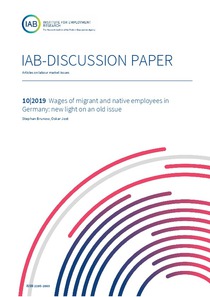Wages of migrant and native employees in Germany: new light on an old issue
"The German workforce is expected to decline in future and labour-oriented immigration should counteract labour shortages. Fair wages in Germany set incentives for foreigners to immigrate there. Therefore this paper aims to shed new light on the decomposition of the wage gap between foreign and...
| Main Authors: | , |
|---|---|
| Institution: | ETUI-European Trade Union Institute |
| Format: | TEXT |
| Language: | English |
| Published: |
Nürnberg
2019
IAB |
| Subjects: | |
| Online Access: | https://www.labourline.org/KENTIKA-19307882124911250649-Wages-of-migrant-and-native-em.htm |
| Summary: | "The German workforce is expected to decline in future and labour-oriented immigration should counteract labour shortages. Fair wages in Germany set incentives for foreigners to immigrate there. Therefore this paper aims to shed new light on the decomposition of the wage gap between foreign and native full-time employees. Using the Mincerian wage equation and the threefold Oaxaca-Blinder decomposition reveals that the wage gap is mostly explained by observable characteristics (endowments), especially location, labour market experience and firm characteristics. Productivity differences can be disregarded with the exception of labour market experience, as foreigners have much flatter experience profiles than native workers. This effect holds for several specifications and potential selectivity and vanishes for foreigners that have resided in Germany for at least ten years and naturalised foreigners. Our results lead to the conclusion that 'discrimination' is negligible from an economic point of view and foreigners receive equal pay." |
|---|---|
| Physical Description: | 48 p. Digital |

